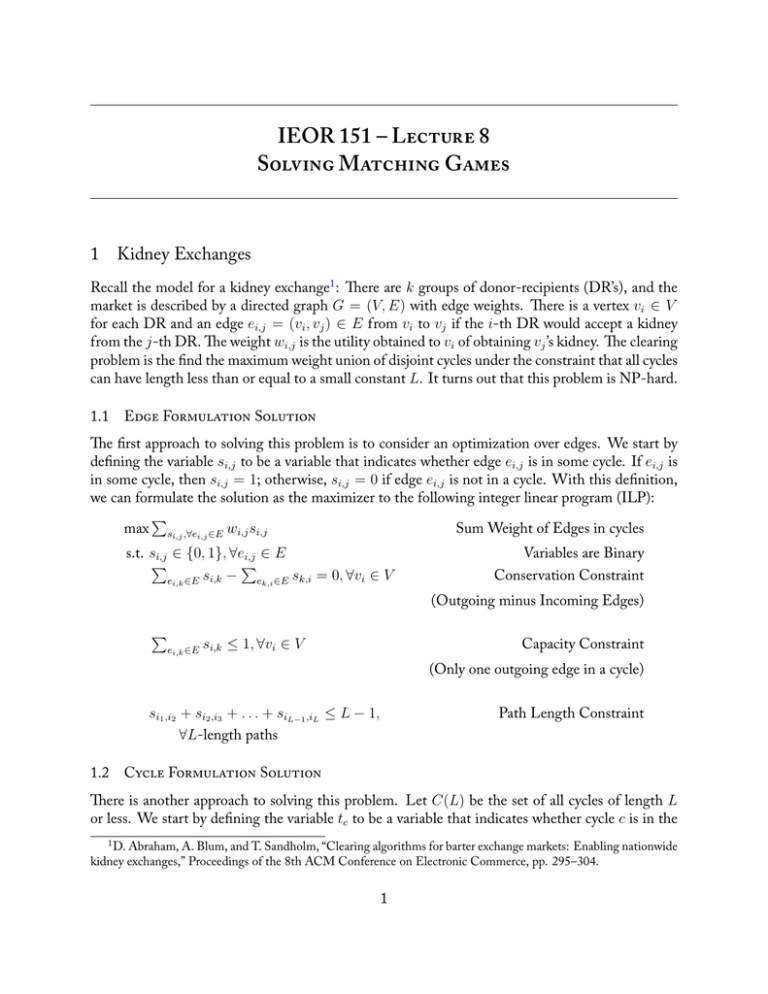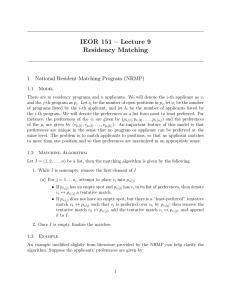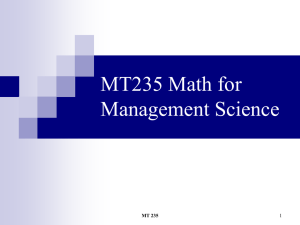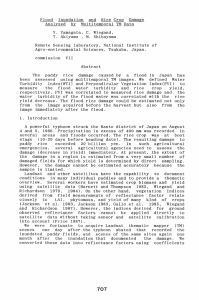IEOR 151 – L 8 S M G 1 Kidney Exchanges
advertisement

IEOR 151 – L 8
S M G
1
Kidney Exchanges
Recall the model for a kidney exchange1 : ere are k groups of donor-recipients (DR’s), and the
market is described by a directed graph G = (V, E) with edge weights. ere is a vertex vi ∈ V
for each DR and an edge ei,j = (vi , vj ) ∈ E from vi to vj if the i-th DR would accept a kidney
from the j-th DR. e weight wi,j is the utility obtained to vi of obtaining vj ’s kidney. e clearing
problem is the find the maximum weight union of disjoint cycles under the constraint that all cycles
can have length less than or equal to a small constant L. It turns out that this problem is NP-hard.
1.1
E F S
e first approach to solving this problem is to consider an optimization over edges. We start by
defining the variable si,j to be a variable that indicates whether edge ei,j is in some cycle. If ei,j is
in some cycle, then si,j = 1; otherwise, si,j = 0 if edge ei,j is not in a cycle. With this definition,
we can formulate the solution as the maximizer to the following integer linear program (ILP):
∑
max si,j ,∀ei,j ∈E wi,j si,j
Sum Weight of Edges in cycles
s.t. si,j ∈ {0, 1}, ∀ei,j ∈ E
∑
∑
ek,i ∈E sk,i = 0, ∀vi ∈ V
ei,k ∈E si,k −
Variables are Binary
Conservation Constraint
(Outgoing minus Incoming Edges)
∑
ei,k ∈E
si,k ≤ 1, ∀vi ∈ V
Capacity Constraint
(Only one outgoing edge in a cycle)
si1 ,i2 + si2 ,i3 + . . . + siL−1 ,iL ≤ L − 1,
∀L-length paths
1.2
Path Length Constraint
C F S
ere is another approach to solving this problem. Let C(L) be the set of all cycles of length L
or less. We start by defining the variable tc to be a variable that indicates whether cycle c is in the
1
D. Abraham, A. Blum, and T. Sandholm, “Clearing algorithms for barter exchange markets: Enabling nationwide
kidney exchanges,” Proceedings of the 8th ACM Conference on Electronic Commerce, pp. 295–304.
1
solution. If tc is in the solution, then tc = 1; otherwise, tc = 0. With this definition, we can
formulate the solution as the maximizer to the following ILP:
∑
max c∈C(L) wc tc
Sum Weight of Cycles
∑
s.t.
Each vertex in at most one cycle
c:vi ∈c tc ≤ 1, ∀vi ∈ V
tc ∈ {0, 1}, ∀c ∈ C(L)
1.3
Variables are Binary
C F
ere are some interesting facts about these two formulations. e edge formulation can be solved
in polynomial time when there are no constraints on the maximum cycle size L, and the cycle
formulation can be solved in polynomial time when the cycle size is at most 2. Also, the LP
relaxation of the cycle formulation weakly dominates the LP relaxation of the edge formulation,
meaning that the LP relaxation of the cycle formulation gives results that are in the worst case as
good as those provided by the LP relaxation of the edge formulation. is is important because
solving the ILP’s for a kidney exchange at the nationwide scale is difficult because of memory and
computational limitations, and so efficient algorithms make use of the LP relaxations. Lastly, for
a graph with m edges, the edge formulation requires O(m3 ) constraints and the cycle formulation
requires O(m2 ) constraints.
2
National Resident Matching Program
Recall our model for the NRMP. ere are m residency programs and n applicants. We will denote
the i-th applicant as vi and the j-th program as pj . Let si be the number of open positions in pi ,
let ai be the number of programs listed by the i-th applicant, and let bi be the number of applicants
listed by the i-th program. We will denote the preferences as a list from most to least preferred. For
instance, the preferences of the vi are given by (pvi [1] , pvi [2] , . . . , pvi [ai ] ) and the preferences of the
pi are given by (vpi [1] , vpi [2] , . . . , vpi [bi ] ). An important feature of this model is that preferences are
unique in the sense that no program or applicant can be preferred at the same level. e problem
is to match applicants to positions, so that no applicant matches to more than one position and so
that preferences are maximized in an appropriate sense.
Let I = (1, 2, . . . , n) be a list, then the matching algorithm is given by the following:
1. While I is nonempty, remove the first element of I
(a) For j = 1 . . . ai , attempt to place vi into pvi [j]
• If pvi [j] has an empty spot and pvi [j] has vi in its list of preferences, then denote
vi ↔ pvi [j] a tentative match.
• If pvi [j] does not have an empty spot, but there is a “least-preferred” tentative match
vk ↔ pvi [j] such that vi is preferred over vk by pvi [j] ; then remove the tentative
match vk ↔ pvi [j] , add the tentative match vi ↔ pvi [j] , and append k to I.
2
2. Once I is empty, finalize the matches.
An example taken from literature provided by the NRMP can help clarify the algorithm. Suppose
the applicants’ preferences are given by:
Anderson
1. City
Chen
1. City
2. Mercy
Ford
1. City
2. General
3. Mercy
Davis
1. Mercy
2. City
3. General
Eastman
1. City
2. Mercy
3. General
Suppose that each program only has two open positions, and that the preferences of the programs
are given by
Mercy
1. Chen
2. Ford
City
1. Eastman
2. Anderson
3. Chen
4. Davis
5. Ford
General
1. Eastman
2. Anderson
3. Ford
4. Davis
en the final match results are given by
Mercy
1. Chen
City
1. Eastman
2. Anderson
3
General
3. Ford
4. Davis










